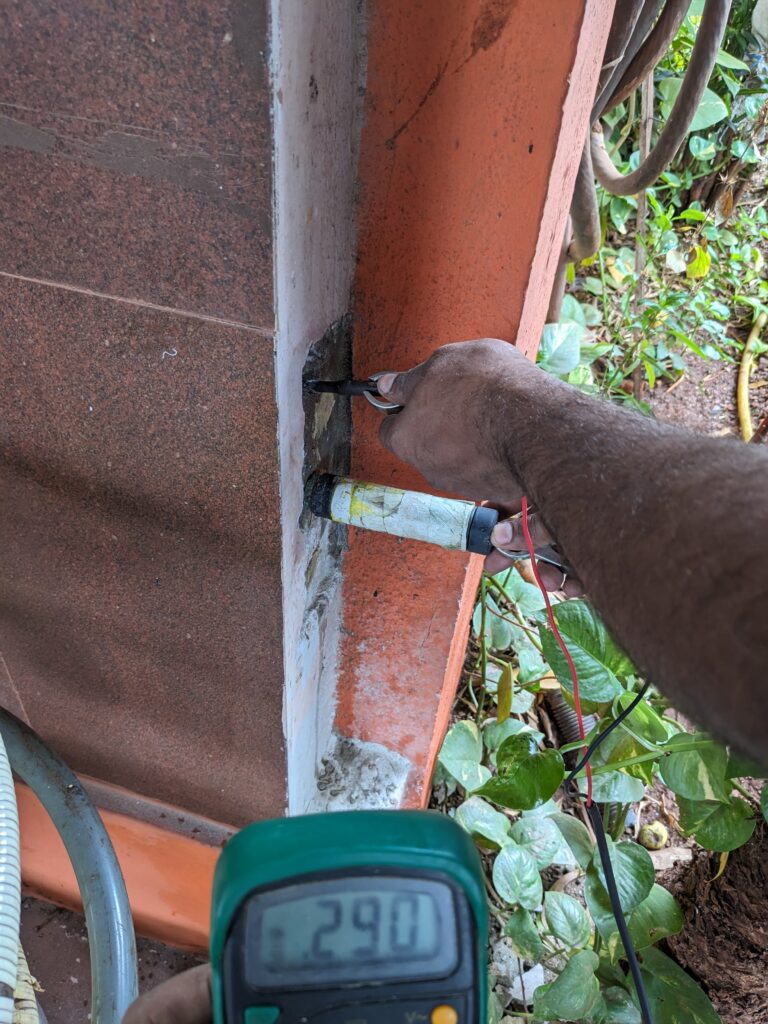Structural audits assess a building’s safety and durability. Corrosion in reinforced concrete can weaken structures over time, leading to significant risks. Half Cell Potential Test (HCP) testing is a widely used non-destructive technique to evaluate corrosion activity in steel reinforcement. This blog explains the importance of Half Cell Potential testing in structural audits, its process, benefits, and challenges.
What is Half Cell Potential Testing?
Half Cell Potential Test (HCP) testing is a non-destructive electrochemical method used to detect corrosion activity in steel reinforcement embedded in concrete. It measures the electrical potential difference between a reference electrode and the reinforcing steel, providing insights into corrosion risk levels.
This test helps engineers determine whether corrosion is actively occurring, allowing preventive measures before serious damage occurs. HCP testing is commonly used in bridges, buildings, and other concrete structures where reinforcement longevity is critical.

Why is Half Cell Potential Test Important in Structural Audits?
A structural audit evaluates the integrity of a building to ensure safety and longevity. Half Cell Potential test contributes to this process by:
- Identifying corrosion-prone areas before visible damage occurs
- Preventing costly repairs by detecting early-stage corrosion
- Ensuring compliance with building safety regulations
- Aiding engineers in making informed decisions about repairs and maintenance
By incorporating HCP testing, structural audits can offer a detailed assessment of reinforcement health, reducing potential risks.
How Half Cell Potential Test Works
Step 1: Surface Preparation
Concrete surfaces are cleaned and prepped to ensure proper electrode contact.
Step 2: Electrode Placement
A reference electrode is connected to the steel reinforcement and placed on the concrete surface.
Step 3: Measuring Potential Difference
The electrical potential is recorded, and variations indicate possible corrosion activity.
Step 4: Data Interpretation
The readings are analyzed to assess the corrosion risk level, guiding maintenance decisions.
Key Benefits of Half Cell Potential Testing
- Non-Destructive: No damage to the concrete structure
- Early Detection: Identifies corrosion before visible deterioration
- Cost-Effective: Reduces repair costs by addressing issues early
- Accurate Assessment: Provides precise data on corrosion risk levels
- Long-Term Durability: Helps maintain structural integrity
Applications of Half Cell Potential Test in Concrete Structures
Bridge and Highway Assessments
Identifies corrosion in bridge decks and concrete pavements to ensure long-term durability.
Building and Infrastructure Inspections
Used to assess reinforcement conditions in residential and commercial structures.
Historical Structure Preservation
Protects heritage buildings by evaluating reinforcement health without invasive methods.
Challenges and Limitations of Half Cell Potential Testing
While Half Cell Potential test is highly effective, some limitations exist
- Surface Preparation: Requires proper cleaning for accurate readings
- Limited Depth Analysis: Measures only the potential difference at the concrete surface
- Moisture Sensitivity: Results can be affected by high moisture levels in concrete
Conclusion
Half Cell Potential testing is an essential tool in structural audits, helping engineers assess reinforcement corrosion before it causes major damage. With its non-destructive nature, accuracy, and cost-effectiveness, it plays a crucial role in ensuring structural safety and longevity.
For construction professionals and auditors, implementing Half Cell Potential testing means improved maintenance strategies and stronger, more durable structures.

Great insights on the Half Cell Potential Test and its importance in structural audits! Just like strong structures require proper testing and evaluation, investing in farmland also needs reliability and trust. At mahabhoomi.site
, you can explore safe and promising farmland property options that ensure long-term value.”
“Great insights on the importance of Half Cell Potential Test in structural audits! It’s always helpful to stay updated with such technical methods for building safety. By the way, if anyone is interested in learning or enhancing their chess skills in Mumbai, I’d recommend checking out SMCA64.com – a trusted chess academy.”